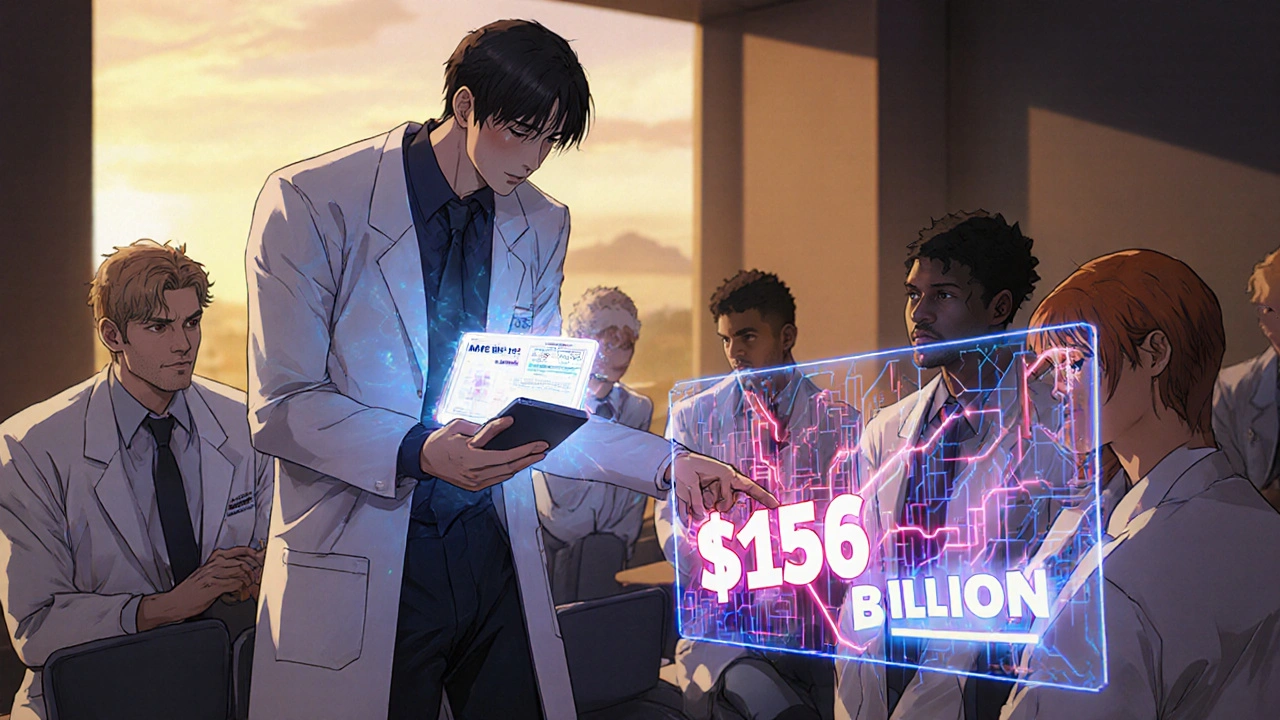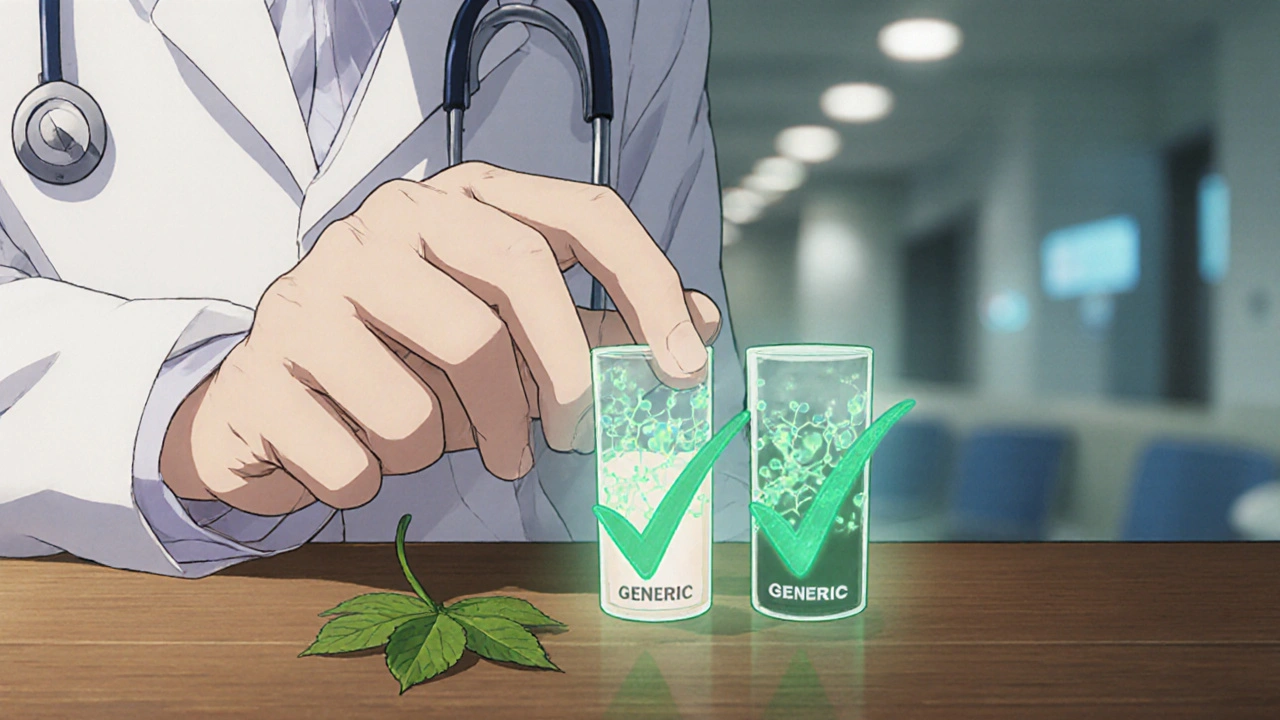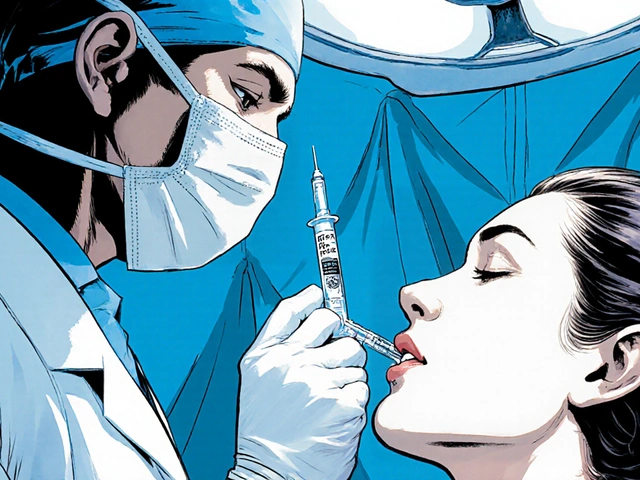Doctors prescribe generics every day-over 90% of all prescriptions in the U.S. are for generic drugs. Yet many still hesitate, unsure if they’re truly equivalent, worried about patient skepticism, or just out of touch with the latest data. The truth? Generics aren’t just cheaper-they’re clinically identical in most cases. But keeping up with that reality requires more than a one-time refresher. It demands ongoing, relevant continuing medical education (CME) that actually connects to daily practice.
Why Generics Matter More Than Ever
Generic drugs make up 90.7% of prescriptions but only 22.9% of total drug spending. That’s $156 billion saved annually in the U.S. healthcare system, according to a RAND Corporation study cited by the American College of Physicians. These savings aren’t theoretical-they’re real for patients choosing between insulin, blood pressure meds, or antidepressants. Yet studies show that when doctors don’t confidently explain why a generic is safe, patient adherence drops. One 2023 study found that when physicians clearly explained bioequivalence, patient concerns about generics fell by 40%.
The FDA doesn’t approve generics lightly. Every generic must prove it delivers the same active ingredient, in the same strength, the same way, and with the same effect as the brand-name version. This isn’t guesswork-it’s a strict bioequivalence standard. If a generic doesn’t perform the same in the body, it doesn’t get approved. The FDA’s Orange Book lists every approved generic and its therapeutic equivalence rating. Yet many doctors never check it.
What CME Requirements Actually Say
CME rules vary wildly by state. Forty states require 20 to 50 hours of CME every two years. Ten states have no mandatory requirement at all. California, for example, demands 50 hours of Category 1 CME every two years-but doesn’t specify how much must be on pharmacology. Meanwhile, Maryland requires three hours of CME on opioid prescribing, with half an hour focused on Prescription Drug Monitoring Programs. Georgia mandates 10 hours of Category 1 credits, including three hours on responsible opioid prescribing for DEA-registered doctors.
The bigger shift? The MATE Act, effective June 27, 2023, now requires every DEA-registered provider to complete eight hours of training on substance use disorders-including education on generic alternatives to controlled substances. That’s not optional. It’s a federal mandate, and full compliance is due by June 2025. This law alone has reshaped how CME providers design pharmacology content.
Even more telling: 68% of state medical boards now require some form of pharmacology-specific CME. And 42 states explicitly include drug nomenclature-knowing the difference between generic and brand names-as part of relicensure. That’s not a suggestion. It’s a requirement.

What Doctors Are Actually Learning
Not all CME is created equal. A 2022 study in Academic Medicine found physicians completed only 68.4% of required pharmacology modules-far below the 87.2% completion rate for clinical topics. Why? Too often, the content feels disconnected. A radiologist forced to sit through 12 hours of pain management CME isn’t learning what they need. They’re checking a box.
But the best programs fix that. Courses from RenewNowCE, for example, include clear learning objectives: “Distinguish generic from brand names,” “Identify common drug interactions,” and “Explain bioequivalence to patients.” One California family physician reported that after taking such a course, she could confidently answer patient questions-and saw a measurable drop in refusal rates.
And it works. The National Board of Medical Examiners found that doctors who completed targeted pharmacology CME improved their generic substitution decisions by 17.3%. That’s not just confidence-it’s better outcomes.
Where the Gaps Are
Not all generics are the same. For drugs with a narrow therapeutic index-like warfarin, levothyroxine, or phenytoin-small differences in absorption can matter. Dr. Alan K. Cohen of Harvard warns that assuming all generics are interchangeable in these cases is dangerous. That’s why ongoing education isn’t just about learning the rules-it’s about understanding the exceptions.
Another blind spot? Biosimilars. These aren’t traditional generics-they’re complex biologic drugs with no exact copy. California updated its CME rules in January 2024 to require two hours of instruction on biosimilars. Other states will follow. Yet most CME platforms still treat them as an afterthought.
And then there’s the issue of access. The FDA approved over 1,000 new generics in 2023 alone. Keeping up means more than annual CME-it means staying plugged in. Resources like the FDA’s free Orange Book Primers and the American Society of Health-System Pharmacists’ online modules are underused. Only 41% of physicians reported using them in 2022.

How to Make CME Actually Useful
The most effective CME doesn’t feel like homework. It integrates into workflow. Over 60% of physicians now use digital platforms, and many are turning to tools like UpToDate, which offers 0.5 CME credits just for reviewing drug monographs during patient care. That’s smart design-learning while you work.
Some systems now use AI to personalize CME based on prescribing habits. By 2027, McKinsey predicts 95% of pharmacology CME will be tailored this way. Imagine getting a short module only on drugs you prescribe frequently-and only when new generics hit the market. No more generic (pun intended) lectures on drugs you never use.
For doctors in specialties like radiology or dermatology, the key is advocacy. Push for CME that reflects your practice. Ask your state medical board: Can we get credit for pharmacology focused on contrast agents, topical meds, or imaging-related drugs? Change happens when enough voices ask for it.
What You Need to Know Right Now
- Generics are bioequivalent to brand-name drugs in over 90% of cases-verified by the FDA.
- The MATE Act requires 8 hours of substance use education, including generics for controlled substances, by June 2025.
- California now requires 2 hours on biosimilars-other states will likely follow.
- Use the FDA’s Orange Book to check therapeutic equivalence ratings before prescribing.
- Choose CME that’s relevant to your specialty, not just what’s easiest to complete.
- Use tools like UpToDate or ASHP modules to learn while you practice.
Doctors don’t need more hours. They need better hours. The goal isn’t to check a box-it’s to prescribe smarter, save patients money, and build trust. Generics aren’t a compromise. They’re the standard. And staying current isn’t optional-it’s part of good medicine.
Do all generics work the same as brand-name drugs?
Yes, for the vast majority of drugs. The FDA requires generics to prove they are bioequivalent-meaning they deliver the same amount of active ingredient into the bloodstream at the same rate as the brand-name version. This ensures the same clinical effect. Exceptions exist for drugs with a narrow therapeutic index, like warfarin or levothyroxine, where small differences in absorption can matter. In those cases, switching between generics or from brand to generic should be done carefully and monitored.
Is CME on generics mandatory for all doctors?
Not uniformly. While 40 states require 20-50 hours of CME every two years, only 68% of state medical boards require pharmacology-specific education, and 42 states include generic vs. brand-name identification as part of their requirements. The MATE Act, however, makes it mandatory for all DEA-registered practitioners to complete eight hours of substance use disorder training-including education on generic alternatives to controlled substances-by June 2025.
Why do some doctors still prefer brand-name drugs?
Several reasons: outdated beliefs that generics are inferior, patient pressure to prescribe the brand, or lack of confidence in explaining bioequivalence. Some doctors also worry about switching patients on narrow therapeutic index drugs. But research shows that when doctors clearly explain why generics are safe and effective, patient concerns drop significantly. The bigger issue isn’t the drug-it’s the communication gap.
What’s the difference between a generic and a biosimilar?
Generics are exact chemical copies of small-molecule drugs. Biosimilars are highly similar-but not identical-copies of complex biologic drugs made from living cells. Because biologics are harder to replicate, biosimilars can have minor differences in structure. They still must prove comparable safety and effectiveness, but they’re not interchangeable by default. California now requires CME on biosimilars, and other states are expected to follow as their use grows.
How can I find good CME courses on generics?
Look for courses accredited by the Accreditation Council for Continuing Medical Education (ACCME). Focus on providers that list clear learning objectives like “Identify generic equivalents,” “Explain bioequivalence,” or “Use the FDA Orange Book.” Platforms like UpToDate, Medscape, and the American Society of Health-System Pharmacists offer targeted modules. Avoid generic “pharmacology” courses that cover every drug under the sun-choose ones tailored to your practice.
Are there free resources to stay updated on new generics?
Yes. The FDA publishes the Orange Book quarterly, listing all approved generics and their therapeutic equivalence ratings. It’s free and searchable online. The FDA also offers free “Orange Book Primers” that explain how generics are evaluated. The American Society of Health-System Pharmacists (ASHP) provides free online modules on generic drug use. Both are reliable, up-to-date, and designed for clinicians-not marketers.







Kathleen Koopman
November 19, 2025 AT 14:17Generics saved me $300/month on my antidepressants 🙌 I wish more docs would just say that instead of acting like it’s some risky gamble. Patients aren’t dumb-we just need clear info.
Nancy M
November 20, 2025 AT 11:35The FDA’s bioequivalence standards are among the most rigorous in the world. It’s not just about cost-it’s about science. When we dismiss generics without evidence, we’re not protecting patients; we’re perpetuating misinformation.
gladys morante
November 22, 2025 AT 06:54Ugh. Another one of these posts. Like we don’t have enough to worry about. Now I gotta learn about Orange Books and biosimilars? No thanks.
Precious Angel
November 23, 2025 AT 19:55Let me tell you something-this whole generics thing is a corporate scam wrapped in FDA paperwork. Big Pharma doesn’t want you to know that generics are often made in the same factories, just without the fancy branding. And don’t even get me started on how the FDA ‘approves’ them-half the time, they’re rushed through because of lobbying. I’ve seen patients crash after switching. It’s not coincidence. It’s negligence. And now they’re forcing us to take CME on it? Like we’re stupid children who need a PowerPoint to believe our own eyes?
Warfarin? Levothyroxine? You think those are just ‘narrow therapeutic index’ drugs? No. They’re the canaries in the coal mine. And the system is ignoring the screaming.
And biosimilars? Please. They’re not even close to the same. Biologics are living molecules. You can’t copy a living thing like it’s a PDF. The FDA lets them pass because they’re cheaper. Not because they’re better. And now California’s making us learn this? Like it’s some kind of medical trivia contest?
Meanwhile, my patient with diabetes just got her insulin switched to a ‘generic’ that cost half as much-and now she’s having seizures. Coincidence? Or is this just how the system works? Profit over people. Always.
I used to trust the system. Now I don’t trust anything. And I’m not the only one.
Melania Dellavega
November 25, 2025 AT 18:38I’ve been thinking a lot about this lately-not just as a doctor, but as someone who’s watched my mom struggle to afford her meds. It’s not about whether generics work. It’s about trust. And trust isn’t built by handing out pamphlets. It’s built by listening, by explaining, by being honest when you don’t know. The best CME I ever took wasn’t a course-it was a conversation with a patient who asked, ‘Why is this pill so much cheaper?’ And I didn’t have a good answer. That moment changed how I practice.
We don’t need more hours. We need more humanity.
Bethany Hosier
November 27, 2025 AT 14:30Wait-so you’re telling me the government is forcing us to take CME on generics… but we’re not told where the pills are made? Or who owns the patents? Or if the active ingredient was sourced from a factory that had a 2019 FDA warning? This isn’t education. This is propaganda. And if you think the FDA is impartial, you haven’t read the whistleblower reports.
Krys Freeman
November 28, 2025 AT 09:44Why are we even talking about this? Americans are weak. If you can’t afford your meds, get a job. Generics are fine. Stop whining.
Shawna B
November 29, 2025 AT 06:30Generics work. I use them. My patients take them. No issues.
Jerry Ray
November 30, 2025 AT 22:22Actually, I’ve had way more issues with generics than brand names. Especially the ones from India. Not all generics are created equal. The FDA is too lenient. You’re selling out your patients for cost savings.
David Ross
November 30, 2025 AT 23:43Let me be unequivocally clear: The MATE Act is a necessary and long-overdue intervention in a broken system. The fact that 68% of state medical boards now require pharmacology-specific CME is not a bureaucratic overreach-it is a clinical imperative. The absence of standardized, evidence-based education in pharmacology has directly contributed to iatrogenic harm, particularly in the context of polypharmacy and therapeutic substitution. The Orange Book is not a suggestion; it is the gold standard. And if you are not consulting it before prescribing, you are not practicing medicine-you are gambling.
Furthermore, the notion that ‘CME feels like homework’ is a symptom of professional disengagement, not a flaw in the system. If your continuing education is not integrated into your workflow, then your workflow is outdated.
Sophia Lyateva
December 2, 2025 AT 04:54genarics r fake drugs made in china by the feds to control us. u think they want us to be healthy? no. they want us dependant. i saw a doc switch my blood pressure med to a generic and i felt like i was dying. they dont care. they just want to save money.
AARON HERNANDEZ ZAVALA
December 4, 2025 AT 01:34I get where everyone’s coming from. Some of you are scared. Some are angry. Some are just tired. But we’re all trying to do right by our patients. Maybe instead of arguing about who’s right, we just share what actually worked for us. I switched my whole clinic to generics last year. Used UpToDate to check every one. Patient complaints dropped. Savings jumped. No one died. Maybe that’s the real CME.
Lyn James
December 4, 2025 AT 20:29This is not a discussion about medicine. This is a discussion about surrender. We have allowed corporations, regulators, and bureaucratic mandates to dictate the very essence of clinical judgment. Generics are not ‘clinically identical’-they are economically identical. The FDA’s approval process is a legal fiction, designed to pacify the public while allowing pharmaceutical conglomerates to monopolize the market under the guise of cost-efficiency. The fact that physicians are now mandated to learn this as if it’s gospel is a tragic indictment of our profession’s moral collapse.
And let’s not pretend biosimilars are anything but a Trojan horse. Biologics are living systems. You cannot replicate a protein folded in a living cell with the same fidelity as a synthetic molecule. To equate them is not science-it is ideological compliance.
When we stop asking ‘Is this right?’ and start asking ‘Is this required?’-we are no longer healers. We are clerks.
Craig Ballantyne
December 6, 2025 AT 12:13While the pharmacoeconomic rationale for generic utilization is well-documented, the clinical heterogeneity in bioequivalence profiles-particularly for narrow therapeutic index agents-remains under-addressed in current CME frameworks. The current paradigm of ‘one-size-fits-all’ pharmacology modules fails to account for specialty-specific prescribing patterns, resulting in cognitive dissonance between didactic content and clinical application. A more granular, AI-driven, context-aware CME architecture is not merely advantageous-it is clinically non-negotiable.
Victor T. Johnson
December 8, 2025 AT 02:19Look, I get it. Generics are cheaper. But I’ve had patients crash after switching. I don’t care what the FDA says. If it ain’t broke, don’t fix it. And if a patient asks for the brand? I give it. End of story. No one’s gonna tell me how to practice.
Nicholas Swiontek
December 9, 2025 AT 04:11This is the kind of post that gives me hope. 🙏 I used to dread CME. Now I look for courses that actually help me talk to my patients. Last week, a mom asked why her kid’s ADHD med was cheaper. I showed her the Orange Book. She cried. Not from sadness-from relief. That’s the real win.